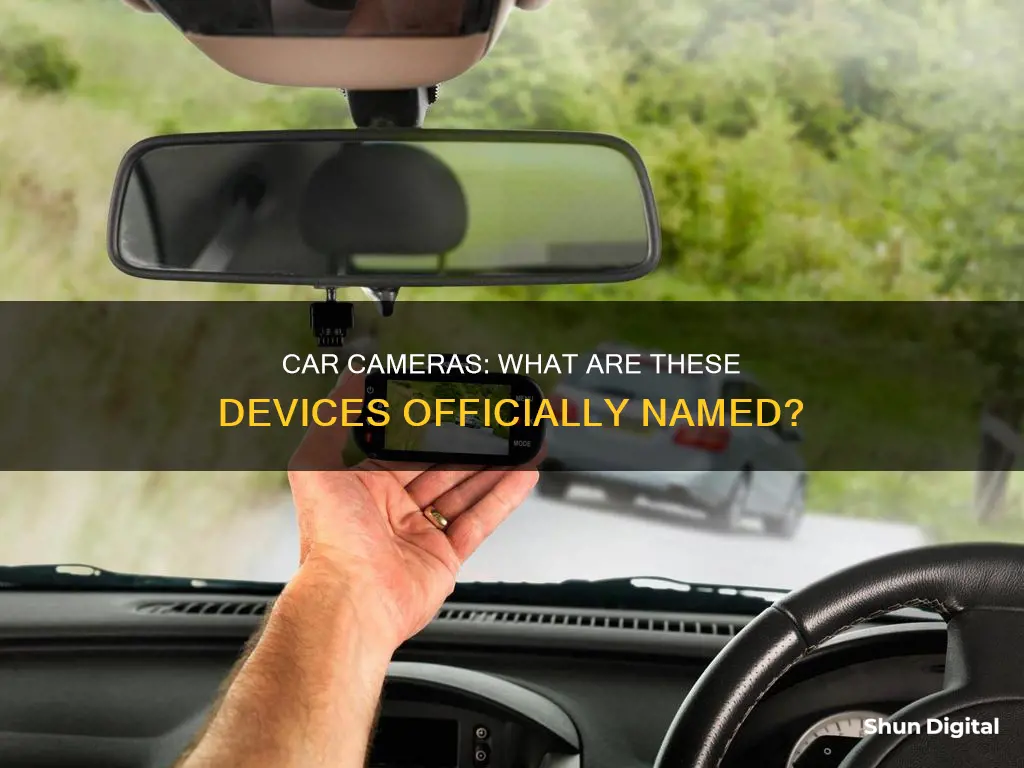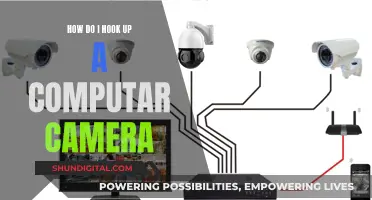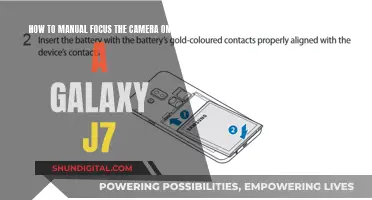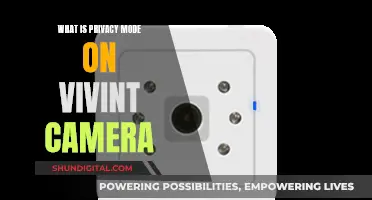
Car cameras, also known as dashcams, are onboard cameras that continuously record the view through a vehicle's front windscreen and sometimes the rear or other windows. They are usually mounted on the vehicle's dashboard or windshield and can be extremely beneficial in the case of accidents for insurance reasons or to present to a court. They can also be used to record the interior of the car and are often used by taxi or rideshare drivers for added safety.
| Characteristics | Values |
|---|---|
| Name | Dashboard camera, car digital video recorder (car DVR), driving recorder, or event data recorder (EDR) |
| Purpose | To act as a "silent witness" in the event of accidents, insurance fraud, police brutality, etc. |
| Installation | Mounted on the vehicle's dashboard or windshield |
| Recording | Continuous recording of the view through the front windscreen and sometimes the rear or other windows |
| Camera Features | Wide-angle (130, 170° or more), night vision, 360-degree view, automatic incident detection, loop-cycle recording |
| Video Quality | Full HD or 1080p (1920x1080) is standard, with some offering 1296p, 1440p, or higher |
| Connectivity | Wi-Fi, Bluetooth, 4G |
| Power Source | Rechargeable batteries, car battery wire, or capacitors |
| Memory | MicroSDHC or MicroSDXC cards (16 GB or higher) or internal memory |
| GPS | Built-in or external GPS antenna |
What You'll Learn
- Car cameras are called dashcams and are also known as driving recorders or event data recorders (EDRs)
- They can be attached to the windscreen, rear-view mirror or dashboard
- They can record the interior of the car in 360 degrees
- They can be used to record road trips or monitor young drivers
- They can help to resolve insurance disputes

Car cameras are called dashcams and are also known as driving recorders or event data recorders (EDRs)
Car cameras are called dashcams, and they are also known as driving recorders or event data recorders (EDRs). A dashcam is a camera mounted on the vehicle's dashboard or windshield to record everything in front of the vehicle and, in some cases, inside the car as well. The primary purpose of a dashcam is to provide an unbiased record of events in case of accidents, insurance claims, or legal proceedings. They can also be used to monitor new or young drivers and record memorable moments during a road trip.
Dashcams come with various features such as HD video recording, ultra-wide viewing angles, night vision, and built-in GPS and G-sensors. They can be attached to the interior windscreen, rear-view mirror, or dashboard using suction cups or adhesive tape. The resolution of dashcams typically ranges from 720p to 1080p or higher, with some models offering 4K resolution.
In addition to standard dashcams, there are also rear-view cameras, side-view cameras, and interior cameras that serve specific purposes. Rear-view cameras assist with parking and reversing, while side-view cameras help with blind-spot monitoring and lane changes. Interior cameras are often used in commercial vehicles for driver identification, fatigue monitoring, and recording safety videos.
Dashcams have become increasingly popular worldwide, with sales skyrocketing in countries like the United Kingdom, Russia, China, and the United States. They are particularly useful in providing evidence for insurance claims and legal proceedings, reducing the time and cost of investigations and claims resolutions. While dashcams offer numerous benefits, there are also privacy concerns associated with their use, and regulations regarding their legality vary across different countries.
Detecting Amcrest Cameras with Windows: A Step-by-Step Guide
You may want to see also

They can be attached to the windscreen, rear-view mirror or dashboard
Car cameras are typically referred to as dashcams, short for dashboard cameras. They can be attached to the windscreen, rear-view mirror, or dashboard in several ways. The most common method is to use a suction cup or adhesive tape to secure the camera in place. Some dashcams also come with a clip-on feature, allowing them to be attached to the rear-view mirror. Additionally, adhesive mounts are an option for a more compact design, enabling the camera to sit closer to the windscreen.
The placement of a dashcam is crucial for optimal recording. A wide-angle front camera with a 130 or 170-degree field of view or more is often attached to the interior windscreen, rear-view mirror, or top of the dashboard. This positioning ensures the camera captures the view through the front windscreen and, in some cases, the rear or other windows.
In addition to the front camera, dashcam systems may include a rear camera mounted on the rear window or registration plate, providing a clear view of the rear of the vehicle. This rear camera typically has a lower resolution, such as 720p, compared to the front camera's 1080p or higher resolution.
Some dashcams also offer a cabin or inside viewing mode, sometimes called a taxicam. These cameras can be attached to the windscreen, dashboard, or other suitable interior surfaces. They may also be integrated into the rear-view mirror, either by employing rubber rings or straps or by directly replacing the mirror itself.
The versatility in mounting options allows users to choose the most convenient and effective location for their dashcam, ensuring they capture the desired footage while maintaining a clear line of sight for driving.
Best Cameras Compatible with the Sony NP-BX1 Battery
You may want to see also

They can record the interior of the car in 360 degrees
Car cameras are also known as dashcams, and they can be used to record the interior of a car in 360 degrees. This is often referred to as "cabin or inside viewing mode" or "taxicam". These cameras are usually in ball form and can be attached to the interior windscreen, rear-view mirror, or dashboard. They can be attached by suction cup or adhesive tape.
Some cabin cams include a screen that can be attached to the rear-view mirror using rubber rings, straps, or as a direct replacement for the mirror itself. Others can be attached to the windshield, dashboard, or other suitable interior surfaces.
In addition to a front-facing camera, many dashcams also have a cabin camera that records the interior of the vehicle, an important safety feature for taxi or rideshare drivers. These in-cabin dash cams, or IR dash cams, are equipped with infrared lights that provide recording details in poor lighting conditions or total darkness.
A 360-degree camera is a technology that is a composite of camera angles from several locations around the vehicle, joining to project an overhead perspective of the vehicle and its surroundings. This image is much like one a drone or blimp would capture. It is invaluable when backing into or out of a confined space, such as a narrow parking spot.
A good example of a 360-degree camera system is the entry-level 2025 Toyota Camry LE. You must move up to the Camry XLE before its Panoramic View Monitor appears as an option. This is part of the Premium Plus Package, bringing the total to $39,255.
There are plenty of aftermarket 360-degree camera kits available, typically including four cameras, required cables, and a control box. However, an aftermarket system will probably not perform as well as a factory-installed one.
Adjusting Honda CR-V Side Camera Focus: A Step-by-Step Guide
You may want to see also

They can be used to record road trips or monitor young drivers
Car cameras, also known as dashboard cameras or dash cams, can be used to record road trips or monitor young drivers. They can be attached to a car's dashboard or windshield and continuously record the view through the front windscreen and sometimes the rear or other windows. Some dash cams also have a 360-degree interior camera to record what is happening inside the vehicle.
Dash cams are a great way to record road trips and create memorable videos or photos. They can capture the scenery, the car's journey on twisty roads, and even the driver's POV and reactions. Additionally, dash cams can be used to monitor young or new drivers and help improve their driving skills. Parents can review the footage and pinpoint risky driving behaviours, such as texting while driving or driving with distractions. This can help open a dialogue about safe driving practices and correct unsafe behaviours before they lead to accidents.
When choosing a dash cam for recording road trips, consider the video quality, ease of use, and mounting options. Look for dash cams with high resolutions like 1080p or 4K, and features like loop recording, image stabilisation, and a wide field of view to capture more details of the surroundings. If you plan to record at night, ensure the dash cam has night vision or infrared capabilities for clear footage in low-light conditions.
For monitoring young drivers, consider dash cams with real-time monitoring features that allow parents to view live footage from anywhere. The BlackVue DR750S-2CH-IR dash cam, for example, offers cloud WiFi capability, allowing parents to connect to the dash cam and monitor their child's driving in real time. This dash cam also has infrared capabilities, providing clear recordings of the driver and car's interior, even at night.
Dash cams are a great tool for recording road trips and monitoring young drivers, providing safety, security, and peace of mind. They can help improve driving skills, ensure safe driving habits, and capture memorable moments on the road.
Traffic Camera Tickets in Diabol Texas: Enforceable or Not?
You may want to see also

They can help to resolve insurance disputes
Dash cams are small cameras that are mounted on the dashboard or windshield of a vehicle. They record everything that happens while driving, including accidents, near misses, and even thefts. They can be powered by a car's cigarette lighter or hardwired into the car's electrical system.
Dash cams can be incredibly useful when it comes to resolving insurance disputes and making insurance claims. They can provide clear and unbiased evidence of what happened during an accident, which can help insurance companies determine who was at fault. This can speed up the claims process and ensure that the right person is held accountable. For example, if you were hit by a texting driver or received an unwarranted citation from law enforcement, dash cam footage could be used to reveal what really happened.
In the case of a dispute over liability, dash cam footage can be used to prove that you were not at fault. This can help to protect you from a major premium increase and lead to a speedier resolution of your claim. It can also help to prevent fraudulent claims, such as \"crash for cash\" schemes, by providing clear evidence of what occurred.
Additionally, dash cams can be useful in capturing incidents that happen to your car when it is parked, such as hit-and-runs or vandalism. Some dash cams have motion sensors and can be set up to record even when the car is turned off, providing valuable evidence for insurance claims.
While dash cams do not typically lower insurance rates directly, they can positively impact your insurance experience by providing clear evidence and speeding up the claims process. They can also encourage safer driving habits, as drivers are more aware of their actions being recorded.
Disabling Camera Mode in VAM: A Step-by-Step Guide
You may want to see also
Frequently asked questions
Car cameras are called dashboard cameras or dashcams.
Dashcams provide safety, security, and peace of mind on the road. They can be used to record incidents around your car while you’re driving, or what happens inside your car. They are also useful for recording road trips or monitoring new drivers.
Some popular dashcam models include the Garmin Dash Cam Mini 2, the Rexing M2 Max Pro 4K WiFi GPS Mirror Dash Cam, and the Nextbase 320XR Dash Camera with Rear Window Camera.







